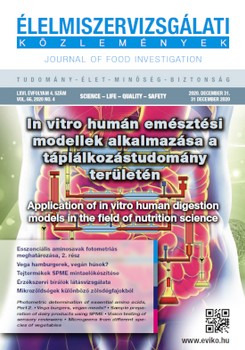Evaluation of various microgreen vegetables
Main Article Content
Absztrakt
As the world’s population grows, more attention needs to be paid to producing foods that provide adequate nutritional value. Microgreens, which are becoming more and more popular today, can be considered such foods. Vegetables in the microgreen category become edible within 7 to 14 days when the cotyledons are fully developed and the first true leaves appear. Compared to adult plants, microgreens have a much higher nutritional value, they contain significant amounts of vitamins (ascorbic acid, tocopherol), minerals and phytonutrients. The amount of these bioactive substances is greatly influenced by environmental factors, including humidity, temperature and light intensity. In our experiment, microgreens prepared species belonging to various plant families, such as Brassicaceae (mustard, radish), Chenopodiaceae (beetroot, Swiss chard) and Lamiaceae (basil), were evaluated based on the (Ca2++Na+)/(Mg2++K+) ion ratio, yield, dry matter and vitamin C content. Microgreens were allowed to develop up to a germination state of 90% protected from light in a germination chamber at a controlled temperature (24-25 °C) and humidity (65-70%). Following germination, after 2 to 3 days, the germination trays were placed in the experimental space of the greenhouse. General potting soil was used as the growing medium, and the seeds were of bio grade, suitable for microgreen cultivation in all cases. The crop was harvested 10 days after sowing, when plant height was 3 to 9 cm, depending on the species. The highest dry matter content ( 10%) was measured in species belonging to the family Chenopodiacea. Mustard contained an outstanding amount of vitamin C (22.66 mg/100 g). In addition, favorable biomass weights were found in the case of radish and mustard (2528 g/m2; 1831 g/m2), while the values for the other species were almost the same ( 500 g/m2). The ion ratio of the human body varies between 2.5 and 4.0, with an optimal value of approximately 1.0. This relationship can be defined as the following ratio: (Ca2++Na+)/(Mg2++K+). The ratio is determined from the occurrence values of the elements expressed in mmol/l [27]. The consumption of vegetables is of paramount importance in establishing this ratio, as their ion ratio is mostly below 1.0. This health-improving effect was proven in the case of the microgreens examined by us, as a value of about 0.40 was obtained for the different species. Overall, it can be stated that mustard showed the most favorable results for the parameters examined.
Letöltések
Letölthető adat még nem áll rendelkezésre.
Article Details
Hogyan kell idézni
Kovácsné Madar, Ágota, & Takácsné Hájos, M. (2020). Evaluation of various microgreen vegetables. Élelmiszervizsgálati Közlemények, 66(4), 3227–3231. Elérés forrás https://eviko.szte.hu/index.php/eviko/article/view/222
Folyóirat szám
Rovat
Tudomány

